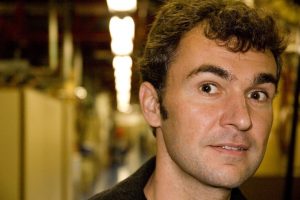BATAVIA, Illinois–At a Washington, DC ceremony today (Monday, June 13), scientist William Ashmanskas of the Department of Energy’s Fermilab will receive the prestigious Presidential Early Career Award for Scientists and Engineers, the highest honor bestowed by the U.S. government on outstanding scientists and engineers who are in the early stages of establishing their independent research careers. Ashmanskas’s citation was for “applying to Fermilab accelerator instrumentation and controls problems the state-of-the-art digital electronics techniques that he and others have successfully applied in recent years in the trigger systems of the CDF experiment.”
Ashmanskas is one of nine DOE scientists, from a total of 58 researchers supported by eight federal departments and agencies, receiving the Presidential Early Career Award. Each Presidential award winner receives a citation, a plaque and a commitment for continued funding of their work from their agency for five years. Dr. John Marburger, Director of the Office of Science and Technology Policy, will present the awards.
At a separate DOE event, the six PECASE winners from DOE national laboratories will also receive the DOE’s Office of Science Early Career Scientist and Engineer Award.
“The Department of Energy is proud that these researchers are making important contributions, in a wide range of fields, to innovation and technology for energy, economic and national security,” Secretary of Energy Samuel Bodman said. “If the outstanding efforts of these scientists and engineers are any indication of the future, I have no doubt they will ensure America’s scientific leadership far into the next century.”
Ashmanskas, whose hometown is Lexington, Mass., has been a member of the CDF detector collaboration since his college years at Harvard University, then during his graduate studies at the University of California at Berkeley and Lawrence Berkeley National Laboratory. As a postdoc at the University of Chicago, he worked on the Silicon Vertex Trigger, which allowed CDF to record bottom and charm decays based on their lifetimes. The results were critical in each of the first three Run II Tevatron physics publications by the detector collaboration. Ashmanskas also led two SVT circuit board designs, several software efforts, and SVT’s commissioning and initial operation.
“This is an honor and a fantastic surprise,” Ashmanskas said of the Presidential award. “But the award should really go to Fermilab and the can-do spirit with which people pulled together to make Run II a success.”
In congratulating Ashmanskas, Fermilab Director Michael Witherell also noted the impact on the laboratory: “We need to attract the best young scientists, like Bill Ashmanskas, to the laboratory and give them the support they need to make advances in physics. The PECASE award program helps us to do that.”
Ashmanskas, a former fellow of the Enrico Fermi Institute at the University of Chicago, is now working primarily on Fermilab’s Antiproton Source — whose performance will be a key factor in the scientific reach of the Tevatron physics program. Ashmanskas hopes that his award will help inspire more young physicists to enter accelerator research. “It will be good for the field if future experimenters consider the accelerator chain to be one more part of their experiment,” Ashmanskas said. “Even today, if you want to find the Higgs boson at Fermilab, you should be working on making antiprotons.”
The Presidential Early Career Award for Scientists and Engineers originated in 1996, when President Clinton commissioned the National Science and Technology Council to create a program honoring and supporting young professionals at the outset of their independent research careers. For more information on PECASE: http://grants.nih.gov/grants/policy/pecase.htm.
William Ashmanskas, Ph.D.

Dr. William Ashmanskas is a scientist at Fermilab, which is home to the Tevatron — an energy-frontier particle accelerator in which protons and antiprotons collide to produce under laboratory conditions the elementary particles that are the building blocks of the universe. Two experiments, CDF and D0, with world-wide teams of nearly 1000 researchers, study the particles produced by the Tevatron.
He has worked with CDF since his college years. As a postdoc, he worked on the Silicon Vertex Trigger project, which provides 50 micron impact-parameter measurements with 15 microsecond latency. SVT allowed CDF to record bottom and charm decays based on lifetime, enabling each of the first three Run 2 Tevatron physics publications. He led two SVT circuit board designs, several software efforts, and SVT’s commissioning and initial operation. While working with the SVT team, he learned a wealth of digital electronics techniques from the engineers at the University of Chicago.
He moved to Fermilab to apply the electronics he learned as a postdoc to accelerator instrumentation problems. Continued evolution in the tools used to observe and to control particle beams will contribute to further progress in the performance and reliability of Fermilab’s accelerators. He is currently working primarily on Fermilab’s Antiproton Source — whose performance in the next few years will be a key factor in the scientific reach of the Tevatron physics program.
Biographical information on all the winners, and their award citations, is available at www.sc.doe.gov
Fermilab is a DOE Office of Science national laboratory, operated under contract by Universities Research Association, Inc.



